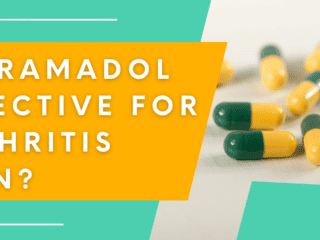Druggenius.com is reader-supported. We may earn a commission through products purchased using links on this page. Learn more about our editorial process here.
Joint pain and stiffness brought on by arthritis can take quite a toll on one’s movement, but pain management methods can help relieve symptoms and promote mobility. Gabapentin is occasionally taken as a pain relief option, but what’s the science behind it?
This article will determine whether gabapentin is effective for arthritis pain, how it works, and how to make the most of it.
Is Gabapentin Good for Arthritis Pain?
Gabapentin, commonly prescribed for nerve pain, has been explored as an option for arthritis pain relief. Compared to other pain medicines:
- NSAIDs (e.g., Ibuprofen): Widely used for arthritis pain. They reduce inflammation but can have side effects like stomach issues.
- Opioids (e.g., Morphine): Strong pain relievers but come with risks like addiction and tolerance.
- Acetaminophen (e.g., Tylenol): Good for mild to moderate pain but doesn’t reduce inflammation.
Gabapentin can be effective for some arthritis patients, especially those with neuropathic pain components. It has a different side effect profile than NSAIDs and opioids, making it a potential alternative for some patients. However, its effectiveness compared to traditional arthritis medications varies among individuals.
What Is Gabapentin?
Overview
Gabapentin is an anticonvulsive medication used to treat epilepsy and partial seizures that come with it among children and adults. It’s also taken to relieve pain caused by certain nervous system conditions.
Common Uses
Gabapentin is mostly used when nerve pain can’t be relieved using other pain relievers like nonsteroidal anti-inflammatory drugs (NSAIDs) and is sometimes used in combination with other drugs to manage pain.
Gabapentin reduces pain by changing how nerves send messages to the brain. When something affects a nerve, the nerve can send false messages to the brain and down the spine, making it think that a part of the body is being hurt. In epileptic seizures, it reduces the abnormal electrical activity in the brain.
One study showed that gabapentin yielded a 50% pain reduction among people who took it while practicing healthy habits, showing its feat as a “moderate quality” pain relief, with limited evidence for its analgesic properties in other types of nerve pain.
Gabapentin & Arthritis Pain – How Gabapentin Works For Arthritis
Scientific Studies and Findings
Scant research exists about the full effects of gabapentin and its properties on arthritis symptoms and other joint-related problems. While gabapentin is generally not prescribed to treat arthritis symptoms, one randomized clinical trial showed that gabapentin, when paired with duloxetine, was shown to have promising effects in pain reduction and improved functional status in patients with knee osteoarthritis over a three-month period, with gabapentin’s effects manifesting gradually at the end of the third month.
Some studies show that gabapentin can cause feelings of relaxation, calmness, and euphoria, promoting better sleep, which people with arthritis struggle to have due to pain and stiffness.
While gabapentin is used for treating epilepsy by calming down nerves, research has shown that gabapentin works in a similar process in helping relieve certain types of pain.
Gabapentin can treat neuropathic pain syndromes and has increasingly been prescribed for nociplastic pain, which some knee osteoarthritis patients can feel along with nociceptive pain. Some studies have also tried to determine whether gabapentin can have anti-inflammatory effects, but nothing conclusive has been found so far.
However, one study showed that incorporating gabapentin into care for knee osteoarthritis patients was not cost-efficient compared to other more popular treatments for arthritis pain.
Risks of Using Gabapentin For Arthritis
Possible Side Effects & Concerns
Many people using this medication do not have serious side effects, but when they do, side effects have been known to occur, such as:
- Drowsiness
- Lightheadedness
- Headaches
- Nausea
- Vomiting
- Diarrhea
- Mood changes
- Swollen arms and legs
- Blurred vision
- Dry mouth
Some of these side effects may decrease after using this medication. Tell your doctor or pharmacist to have them prescribe you a lower dosage or switch to another medication completely if these effects worsen.
The following serious side effects have also been reported:
- High fever
- Swollen glands
- Yellowing eyes or skin
- Unusual bruises or bleeding
- Muscle pain
- Severe tiredness or weakness
Some users have reported that gabapentin can act similarly to a stimulant, where it can enhance the euphoric effects of other drugs, like heroin and other opioids, and is likely to increase the risks when taken in this way.
One study showed that gabapentin (paired with pregabalin) showed an increased risk of adverse cardiovascular problems within 5 years,
In case of persistent side effects from gabapentin, speak to your doctors, nurse, or pharmacist immediately.
Precautions
Gabapentin comes in 100 mg, 300 mg, and 400 mg capsules and 600 mg and 800 mg tablets.
Oral solutions come in either 250 mg or 5 milliliters (mL). However, dosages can vary depending on a person’s condition, age, and weight.
Dosage Tips
You should take gabapentin as your healthcare provider prescribes according to your pain level. For example, if the symptoms disappear with a lower dose, you can stay with the same amount rather than increase it.
Gabapentin should be taken in addition to other pain-relieving medications like paracetamol, ibuprofen, and aspirin unless told otherwise. It’s usually given at a lower dose and increased gradually to minimize side effects.
If you missed a dose, you should take it as soon as you remember. However, if it’s almost
time for the next one, skip the missed dose and take your medication normally. Avoid doubling dosages to make up for the missed dose.
Who Shouldn’t Take Gabapentin
Before taking gabapentin, you should tell your doctor if you’ve had any of the following:
- A history of allergic reactions to gabapentin or any other medicine
- Diabetes or pre-diabetes
- Trying to get pregnant (or are already pregnant)
- Currently on a controlled sodium or potassium diet
- History of drug abuse or alcohol abuse problems
- Kidney problems (Currently being in dialysis)
- History of mental illness, mood problems, depression, or have had prior suicide attempt(s)
Interactions
Gabapentin can interact with medications and substances such as losartan, ethacrynic acid, caffeine, phenytoin, mefloquine, magnesium oxide, cimetidine, naproxen, sevelamer, and morphine.
Alternatives To Gabapentin For Arthritis Pain
Over-the-counter (OTC) & Other Prescription Pain Relievers
Many studies show that pairing NSAIDs, COX-2 inhibitors, and analgesics helps improve pain and physical function in knee/hip osteoarthritis patients by inhibiting prostaglandins’ biosynthesis at the cyclooxygenase enzyme level. One clinical trial showed that OTC medications help provide moderate and clinically meaningful pain relief and function in patients with short-term hand, hip, or knee osteoarthritis.
Over-the-counter pain relievers and prescription drugs have been effective for people with mild to moderate flare-ups of knee pain. Among such drugs include ibuprofen (Advil), acetaminophen (Tylenol), naproxen (Aleve), duloxetine (Cymbalta), meloxicam (Mobic), oxaprozin (Daypro), and piroxicam (Feldene).
Topical creams like capsaicin cream and Diclofenac-based topicals (Voltaren/Pennsaid) are safe and highly effective treatments in relieving arthritis and are also effective in pain management.
Healthy Diet And Weight Management
Eating a healthy diet helps prevent unwanted weight gain and reduces the effects of osteoarthritis. Studies show that foods rich in excess fats, sugars, grains, and other carbohydrates result in unhealthy weight gain, which increases the risk of the body lapsing into an inflammatory state and adding pressure to the joints.
An unhealthy diet can also upset the gut microbiome balance, trigger the inflammatory process, and cause symptoms. Foods high in food colorings, additives, artificial sugars, and preservatives may increase the risk of joint inflammation, especially when consumed in excess.
Observing a Mediterranean diet consisting of omega-3-rich fish like salmon or sardines, legumes, whole grains, nuts, dairy, garlic, fruits, and dark leafy greens can help reduce the effects of arthritis and inflammation in the body and strengthen bone density.
Regular Exercise
Doing low-impact exercise routines can relieve arthritis pain and stiffness. Simple cardio/aerobic exercises like walking, swimming, biking, tai chi, and yoga keep the heart and lungs strong, while resistance exercises like pushups and lunges help strengthen muscles and support your joints.
Stretching exercises promote flexibility and ease arthritis joint pain and stiffness, while isometrics exercises like plank holds and wall sits work and build muscles without moving the joints.
If unsure which exercise type works best, check physical therapist or fitness coach for a personalized exercise plan.
Acupuncture
Acupuncture stimulates endorphins, serotonin, dopamine, and oxytocin, the body’s natural painkillers and neurotransmitters, stimulating nerve and energy pathways to boost blood flow and brain activity.
A recent study found acupuncture effective in relieving pain and disability and improving the quality of life in people with people suffering from rheumatoid arthritis in the hand.
Stress Management
When a person is under stress, the body’s stress response fires up the immune system’s inflammatory response, which increases muscle tension, resulting in joint pain and an increased risk of arthritis.
Studies show that relaxation techniques such as deep breathing, yoga, meditation, tai chi, exercise, and prayer can mitigate joint tension.
The RICE Method
The RICE method stands for Rest, Ice, Compression, and Elevation. It’s a self-care technique that helps reduce swelling and pain. It’s often applied as an immediate treatment for joint-related problems.
For arthritis pain, it can be done like this:
- Rest – Get adequate rest after experiencing pain. As much as possible, avoid intense physical activities that can trigger arthritis pain and other symptoms.
- Ice – Put an ice pack over the affected joint(s) several times daily for up to 20 minutes. Avoid applying the ice directly.
- Compression – Wrap the joint firmly with a bandage or compression sleeve. The compression reduces swelling and tension around the injury and helps speed healing.
- Elevation – Elevate the affected body part above the level of your heart to decrease swelling and joint pain.
FAQs
Is gabapentin considered a narcotic?
Gabapentin isn’t considered a narcotic or a federally controlled substance. However, it is regulated and recognized as a controlled substance in states like Alabama, Kentucky, Michigan, North Dakota, Tennessee, Virginia, and West Virginia.
How long can I take gabapentin for arthritis pain?
You should take gabapentin in addition to your current tablets unless told otherwise. If the gabapentin is helpful, you can continue, and your treatment will be reviewed regularly. It is also important to continue taking your regular painkiller unless your doctor has advised you to stop taking these.
Can I take gabapentin with other arthritis medications?
Gabapentin, per se, isn’t usually prescribed for arthritis. However, it can be paired with other medications like paracetamol, ibuprofen, aspirin, and nonsteroidal anti-inflammatory drugs (NSAIDs)
Are there any natural remedies that work similarly to gabapentin?
Suppose you’re experiencing side effects from taking gabapentin. In that case, your doctor may give you a lower dosage or have you eat a meal before taking the medication to mitigate any possible side effects.Â
What should I do if I experience side effects from gabapentin?
If you have troublesome side effects from gabapentin, speak to your doctors, nurse, or pharmacist immediately to adjust or lower your dose. You also might be recommended to eat a meal before taking the medication to mitigate possible side effects.
If the side effects persist, your healthcare provider might substitute gabapentin completely with another more suitable medication/drug.
Conclusion
Gabapentin controls partial seizures in people with epilepsy and nerve pain.
Based on various studies mentioned above, it does show promise in improving pain and function in people with osteoarthritis, providing moderate relief. However, other medications or prescription drugs may be more effective than gabapentin for arthritis.
Before considering taking gabapentin for arthritis pain, it’s important to consult your trusted doctor/healthcare professionals before further medicating to see if the medication suits you best and help you consider other possible treatment options for arthritis symptoms.
Disclaimer: this article does not constitute or replace medical advice. If you have an emergency or a serious medical question, please contact a medical professional or call 911 immediately. To see our full medical disclaimer, visit our Terms of Use page.









